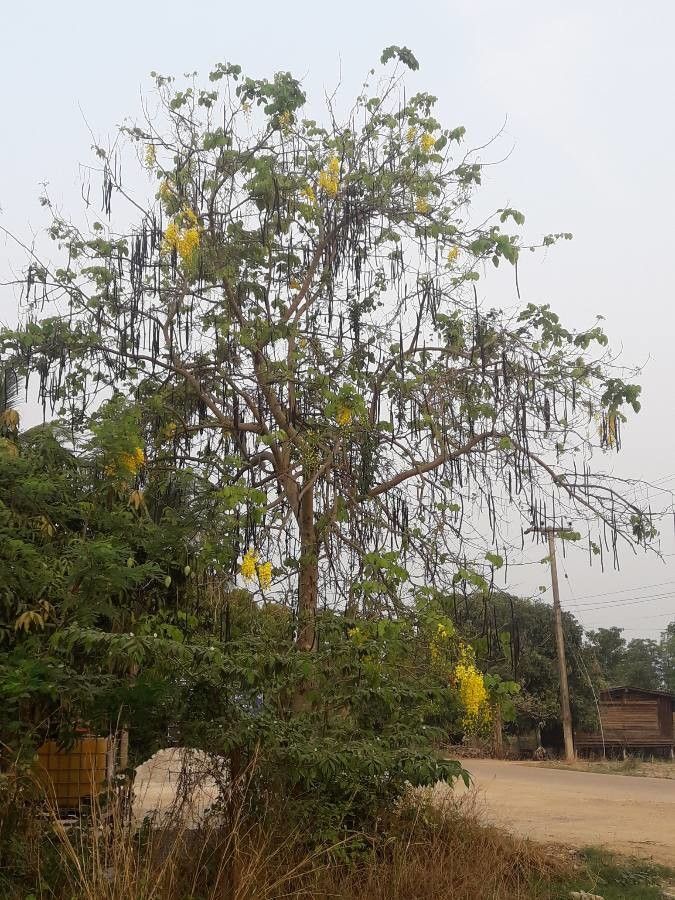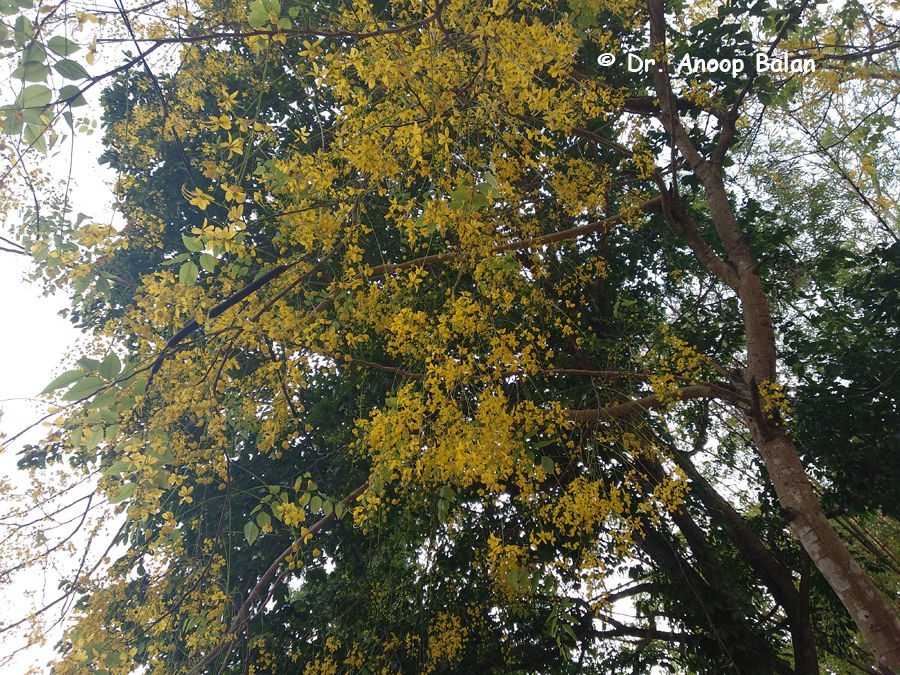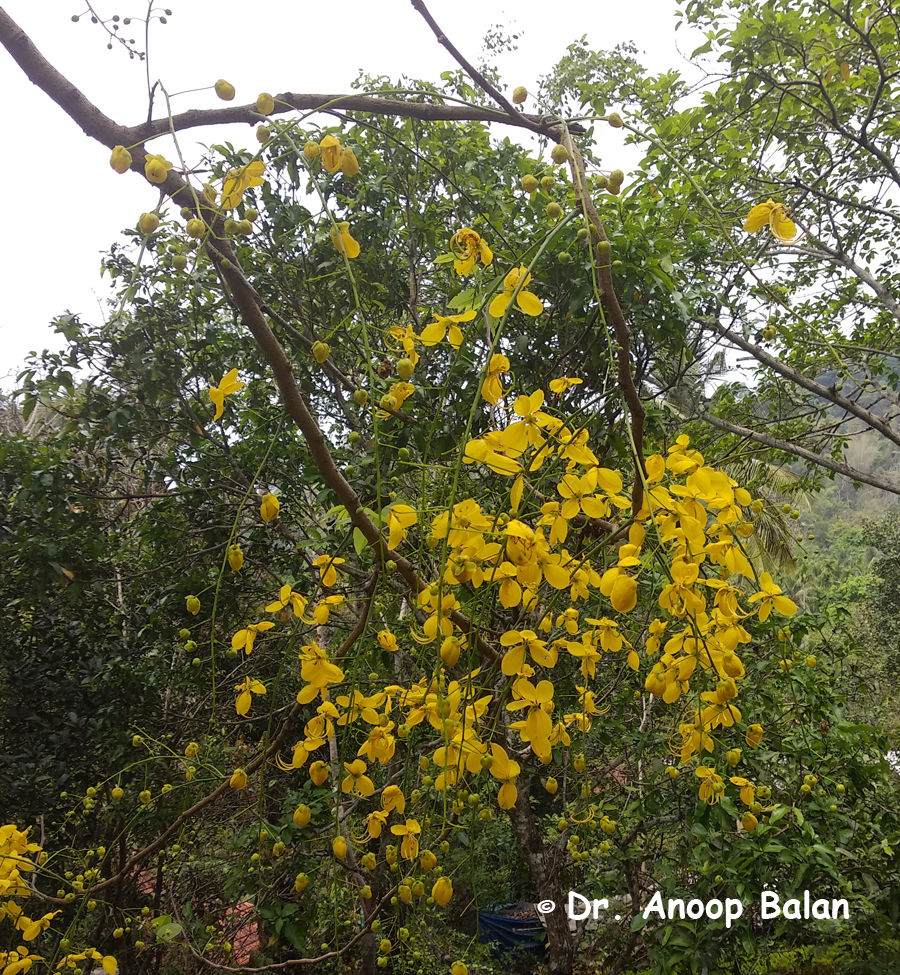Golden Shower Tree
cassia fistula
Also known as: ["Indian Laburnum","Purging Cassia"]
Overview
A deciduous tree known for its striking yellow flower clusters and long, cylindrical seed pods.
Benefits & Perks
["long-flowering","wildlife attractant (bees, butterflies, birds)","drought tolerant"]
Botanical Classification
| Phylum: | Magnoliophyta |
| Class: | Magnoliopsida |
| Order: | Fabales |
| Family: | Fabaceae |
| Genus: | Cassia |
| Botanical Name: | Cassia fistula |
Plant Characteristics
Basic Information
- Category: Trees
- Suitable Location: outdoor garden in tropical or subtropical regions
- Suitable For:
- Is Weed: No
- Allergenicity: low
Environmental Needs
- Climate: {"temperatureRange":"15–35°C"}
- Hardiness: {"zones":"9–11"}
- Misting: rarely required
- Drainage: Fast-draining to prevent root rot.
- Soil Type: Well-draining, loamy soil with organic matter; can tolerate slightly sandy or clay soils if amended.
Maintenance Level
- Maintenance Level: moderate
- Toughness Level: high
- Pruning Frequency: Annually in late winter or early spring before new growth.
- Pruning Intensity: Moderate; remove up to one-third of old growth if needed.
Care Details
Ideal Sunlight Coverage:
Full sun (6–8 hours/day); tolerates partial shade but blooms best in direct sunlight.
Sunlight Tolerance Tips:
Acclimate gradually if moving from shade to sun; protect from intense midday sun in hot climates; ensure good air circulation to prevent fungal issues.
Care Requirements
Care Difficulty
moderatemoderate
Sunlight
full sun
Rotate plant for even growth; use shade cloth in extreme heat; avoid direct sun on leaves during peak hours.
Watering
every 7–10 days during growing season, less frequently in winter
Water thoroughly until runoff; allow soil to dry between waterings; avoid overhead watering.
Soil
well-drained, loamy soil
pH: Slightly acidic to neutral (6.0–7.0).
Use raised beds in heavy soils; avoid compacted soil; topdress with compost annually.
Temperature
Thrives in 65–85°F (18–29°C); tolerates brief dips to 50°F (10°C) but prefers warmth.
Protect from frost; ensure good air flow in heat; adjust watering with temperature.
Fertilizing
every 2–3 months during active growth
Fertilize before new growth; water before applying fertilizer; flush soil occasionally to prevent salt buildup.
Propagation
Methods
Stem cuttings or seeds; stem cuttings are more reliable for home growers.
Step-by-Step Propagation Guide
- Take 4–6 inch cuttings.
- Remove lower leaves.
- Dip in hormone.
- Plant in medium.
- Keep moist and warm.
Best Time: Spring or early summer when the plant is actively growing.
Environment
High humidity (70–80%), warm (75–85°F), partial shade.
Medium
Well-draining mix of perlite and peat moss or cactus mix.
Hormone
Recommended to use rooting hormone for faster root development.
Timeline
Roots in 4–8 weeks; establish in 3–6 months.
Tools Needed
Pruners, rooting hormone, small pots, misting spray bottle.
Quick Tips
Use healthy, non-flowering stems; maintain consistent moisture; provide bottom heat if possible.
Pruning & Repotting
Pruning Guide
Method
Selective thinning and heading back to maintain form.
Pruning Plan
Shape the plant, remove dead or crossing branches, and encourage airflow and flowering.
Tools
Pruning shears, loppers, gloves.
Checklist
Sterilize tools; prune dead/diseased wood first; make clean cuts; dispose of clippings.
Repotting Guide
Best Season
Early spring before active growth begins.
Pot Size
Move to a pot 2–3 inches larger in diameter.
Method
Remove plant gently; trim roots if crowded; replace with fresh soil mix; ensure good drainage.
Suggestions
Repot every 2–3 years or when roots fill the pot; necessary to refresh soil and provide space.
Checklist
Check root bound status; prepare new pot with drainage; use fresh soil mix; water after repotting.
Advanced Care Tips
Watering Mastery
Watering Checklist
Check soil moisture; water deeply; ensure drainage; adjust for season.
How to Apply Water Properly
Water at the base of the plant, ensuring moisture reaches the root zone; water early in the morning to minimize evaporation; ensure excess water drains away to prevent waterlogging.
Watering Schedule Tips
Water deeply once the top inch of soil is dry; reduce frequency in winter to prevent root rot.
Soil Improvement
Add perlite or sand for drainage; incorporate compost for fertility; ensure good aeration.
Temperature Stress Management
Signs of Temperature Issues
Leaf drop, yellowing, or stunted growth in cold; wilting or scorching in excessive heat.
Cold Stress
Slows growth, may cause leaf drop; prolonged cold can damage roots and buds.
Solution: Move to a sheltered location; apply mulch to protect roots; avoid overwatering in cold.
Hot Stress
Leaves may wilt, scorch, or drop; flowering may be reduced.
Solution: Provide shade during peak heat; increase watering; mist leaves in the morning.
Fertilizing Guide
Fertilizing Checklist
Check season; use correct dilution; apply to soil, not foliage; avoid winter feeding.
Fertilizing Method
Use balanced, slow-release fertilizer in spring and summer; dilute liquid fertilizer to half-strength monthly during growing season; avoid fertilizing in winter.
Common Problems & Solutions
Toxicity Warning
Cats
ToxicCats are particularly sensitive to the toxic compounds in Cassia fistula. Ingestion of seeds or pods can cause severe gastrointestinal irritation and systemic effects, potentially leading to more serious health complications.
⚠️ Symptoms:
🌿 Toxic Parts:
⚡ Toxic If:
if eaten
Dogs
ToxicThe seeds and pods of Cassia fistula contain compounds that can cause significant gastrointestinal upset in dogs. The anthraquinone glycosides can lead to severe diarrhea and dehydration, which may require veterinary intervention.
⚠️ Symptoms:
🌿 Toxic Parts:
⚡ Toxic If:
if eaten
Humans
ToxicCassia fistula contains anthraquinone glycosides, which are known to have purgative effects on the human gastrointestinal tract. Ingestion can lead to severe gastrointestinal distress and potential systemic toxicity if consumed in large quantities.
⚠️ Symptoms:
🌿 Toxic Parts:
⚡ Toxic If:
if eaten
Frequently Asked Questions
Q: Is Cassia fistula toxic to pets?
A: Mildly toxic to dogs and cats if ingested.
Q: Does the Golden Shower Tree attract wildlife?
A: Yes, it attracts bees, butterflies, and birds with its flowers.
Q: How often does Cassia fistula bloom?
A: It typically blooms once a year, producing a profusion of yellow flowers.
Quick Reference
| Family: | Fabaceae |
| Care: | moderate |
| Light: | full sun |
| Water: | every 7–10 days during growi |
Get Expert Care Tips
Download the Plantious app for personalized care reminders and plant identification!
Google Play App Store








